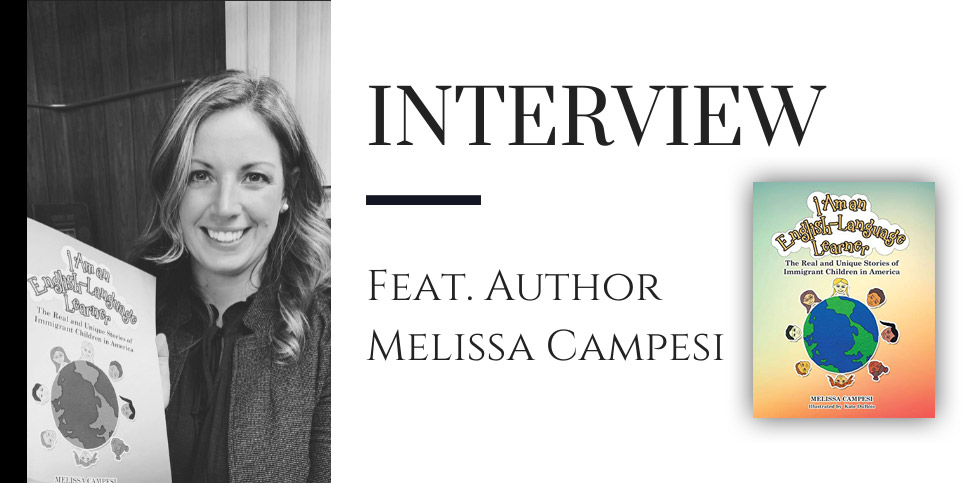Author Showcase
Sponsored*
The Children’s Book Review | November 6, 2019
Melissa Campesi is a dedicated English as a Second Language educator in New Jersey. She grew up in a bilingual household with her mother, a Cuban refugee, father, a Queens native, and a younger brother. She lived in the same apartment house with her maternal grandmother, who helped raise her and only spoke to her in Spanish. Since being immersed in a bilingual environment, her love of language and culture flourished.
As a child and teenager, she would visit her grandmother’s hometown in northern Spain during summers and enjoyed connecting with family and friends. Melissa and her family also traveled to many parts of Europe, North America, and the Carribean. These experiences shaped her to become a more culturally perceptive person. Every visit revealed that learning about other cultures meant understanding new viewpoints.
In college, Melissa majored in Speech & Language Pathology with a minor in Spanish. She then pursued her Masters in Elementary Education and became certified in teaching English as a Second Language. Melissa has worked with both ESL children and adults from all over the globe. Her students were the motivation in writing her first children’s book, I am an English Language Learner.
The Children’s Book Review: I Am an English Learner takes readers into an English as a second language (ESL) classroom. Tell us how your experience as an ESL teacher inspired you to write this book.
Melissa Campesi: The greatest reward I receive as an ELL teacher is connecting with my students through their cultural and creative identities. I look forward to the moments when my students feel comfortable enough to open up about their personal experiences. No language barrier could ever prevent me from getting to know each student individually. My goal is to encourage the art of sharing gently. This can take time, depending on the students’ personality and language level. They bring much knowledge to our classroom by just expressing what they already know. Their stories are assets to my lessons, and listening to them impacted my life immensely. My students and their stories were my motivation and inspiration in writing this book. I hope this book opens the conversational pathways for young storytellers from all walks of life to share their stories.
Your book provides readers with access to a set of real and unique stories of immigrant children in America. Are all of the students named in the book students that you have taught?
The characters in my book are a mix of English language learners who have impacted different stages of my life. The stories collected for my book were my mother’s Cuban refugee story, my dear friends Luckens from Haiti and Kati from Estonia, an ELL colleague and friend Claudia from Mexico, and four adult students: Kunihiko from Japan, Priya from India, Zainab from Sierra Leone, and Edgar from Ecuador. The purpose of choosing adults instead of children is their ability to describe memories, emotions, and aspirations. I intentionally transformed the characters in the book as children, so they are relatable to young readers.
The introduction immediately has readers stepping into the shoes of others: “How would you feel if your family moved to a new country where people spoke another language?” Was it intentional to plant this seed of empathy before readers meet the eight students?
Yes, it was intentional to plant the seed of empathy before introducing the students’ stories. I have many messages embedded in this book – one being empathy. I believe if we begin discussing and hearing different perspectives at a young age, our world will be a more harmonious place.
The introduction also notes the importance of pronouncing names correctly. The correct pronunciation is provided for each child we meet within the pages. Can you elaborate on this importance?
As simple as it sounds, your name holds the power of identity. Pronouncing someone’s name reinforces their importance in our world. All teachers and caretakers want their students to feel confident and a sense of belonging. Not pronouncing a child’s name may have them feel like they are not part of this new tribe, risking their confidence and self-assurance to deteriorate. We want to mirror the whole child in a positive light. The first step in this reflection is addressing the students’ names the way their families say it. Also, many names hold family, spiritual, or religious meanings, such as my name, Melissa Aurora. Melissa is from my mother and great-grandmother’s name, Elisa, and my middle name, Aurora, is the name of my other great-grandmother. I feel both these names keep me linked to the stories and customs of my family.
Each child’s story begins with a hello in his or her native language. Learning to say hello in a new language can be fun, but also a giant barrier breaker. Was this why you chose to start each child’s introduction this way?
Yes, I view greetings as wonderful conversation warm-ups! A simple greeting routine ignites more in-depth student dialogues. Class sessions always begin with students sitting in a circle, exchanging eye contact, addressing each other by their first name, and then offering a kind greeting. This is a genuine way for students to reacquaint themselves in my classroom. Students are encouraged to slowly open up while practicing expressive social language skills in English. Since all humans are curious beings, especially children, I found they would love to learn new words from their classmates’ native languages. This was a fun way to incorporate multilingual vocabulary. When a student heard a word in their native language, they instantly felt at home.
The stories highlight unique cultural experiences through the sharing of their favorite things from their country: foods, games to play, festivals, and special holidays. How do you honor and celebrate the students’ heritage and culture within the classroom?
Honoring and celebrating our students’ holidays or festivals are meaningful events to look forward to during the school year. The key to making these events successful is by embracing and welcoming parent involvement. Immigrant parents may be reluctant to want to participate in school activities because of language or cultural barriers. However, once they know you want to honor their country by celebrating a holiday in the classroom, they are ready to go above and beyond for their child, peers, and teachers. Discover what holidays your students observe and how they celebrate them. Parent volunteers are usually willing to present artifacts that represent their culture. I also acknowledge my students’ cultures by wearing their traditional dress, exhibiting cultural artworks, playing educational videos, and displaying books about the holiday/festival in our classroom.
There is a repeating theme that when the students are shown kindness and patience, they feel encouraged to keep on learning. These actions help melt fears away. What are three simple ways that readers could demonstrate compassion to fellow students who may be immigrants?
When it comes to learning, especially language learning, the best way to absorb new knowledge naturally is when our minds are at ease. When students feel stressed or insecure about learning, gaining new knowledge will be blocked. Demonstrating compassion, kindness, and patience are the best ways to eliminate anxiety and self-doubt. We want all students to feel confident and in control of their learning; this is how they will feel successful in the classroom and life. Here are three simple ways readers can demonstrate compassion to immigrant students:
- Welcome Them! Introduce yourself and let them know you are here to help. If they do not understand, perhaps draw or find a picture representing friendship and show how you can assist them with daily routines in your classroom.
- Learn New Words! Show your new friend you are interested in learning about them and their culture. See if they can teach you how to say “hello” in their native language. Practice using this greeting with them. They will feel appreciated if you give it a try!
- Check-in! Ask your friends daily how they are doing. If they are not able to communicate with words yet, have them draw pictures or show pictures of faces displaying different emotions (happy, sad, excited, nervous, etc.) This will demonstrate that you care about their feelings.
There are color illustrations throughout, providing a visual of each child, their home country, and the flag of their nation. How do you select Kate DuBois as the illustrator?
I met Kate DuBois through a mutual friend at a vision board party about three years ago. The party consisted of a group of diverse women discussing their visions and goals for the new year. I shared my dream of writing a book on cultural awareness, and Kate expressed her aspirations of being an artist. From there, we instantly connected and exchanged information to make this book become a reality. Although our creative outlets may different, we both shared the same perception of the importance of cultural inclusivity. Together, with her magical artistry and the influential stories of the characters, we produced this unique and inclusive children’s book!
What do you hope young readers and their parents will take away from reading your book?
I hope readers and parents take away two concepts from this book: (1) Curiosity creates connections and (2) Share your stories
Most human connections are initiated by genuine curiosity. Getting to know one another through friendly questioning is the best way to start! We can uncover much about ourselves and others by simply asking and engaging in kind-hearted conversations.
This book also promotes the art of storytelling. We all have intimate stories to share. I am not suggesting to share your stories with the whole world, but perhaps with one close friend or teacher. Everyone’s story can make an impact in someone else’s life. Writing or telling our own stories helps define our identities and allows others to understand, empathize, and learn new perspectives. This concept will allow our society to become more open-minded to embrace new and unfamiliar ideas.
Is there anything else you would like to share with our readers?
Always have open ears, eyes, hearts, and minds for the people and the world around you! The best education comes from learning about one another.
—
Written by Melissa Campesi
Illustrated by Kate DuBois
Publisher’s Synopsis: All around the world, people speak, read, and write in many different languages. Some languages have different alphabet systems, and others make sounds that don’t exist in English. Not only can our languages be different, but so can the ways we dress, eat, and greet others. When children come to the United States from other countries and need to learn English, they become English language learners. I Am an English-Language Learner introduces eight children from various countries who are learning English in their new homes. They share what they miss about their native countries, how they feel about living in the United States, and what they dream of doing. Each one has a new story and unique journey, helping everyone understand that the best education comes from learning about one another. This children’s book introduces young readers to new customs and cultures through the stories of students who are learning English as a second language.
“I Am an English-Language Learner is a must-read for all elementary school-aged children and their parents. It can only open hearts and minds with the connections it aims to make.” — The Children’s Book Review
Ages 6+| Publisher: Self-Published | 2019 | ISBN-13: 978-1-6847-0822-2
Buy the Book
Learn More
The Author Showcase is a place for authors and illustrators to gain visibility for their works. ‘Melissa Campesi Discusses I Am an English-Language Learner’ is a sponsored* interview. Discover more great writing and illustrating artists in our Showcase.

